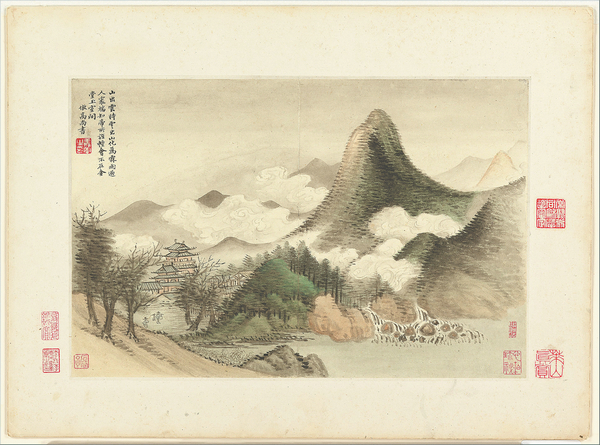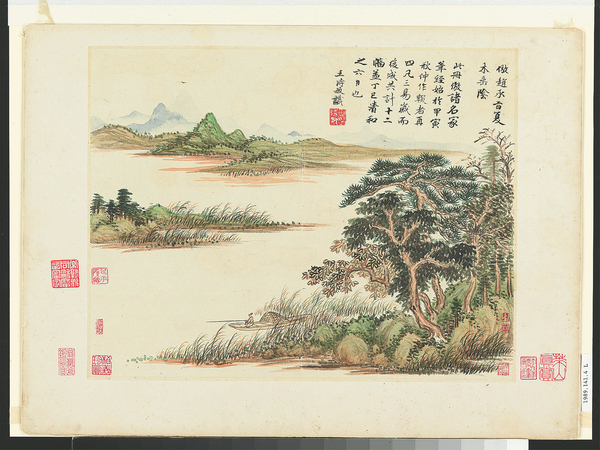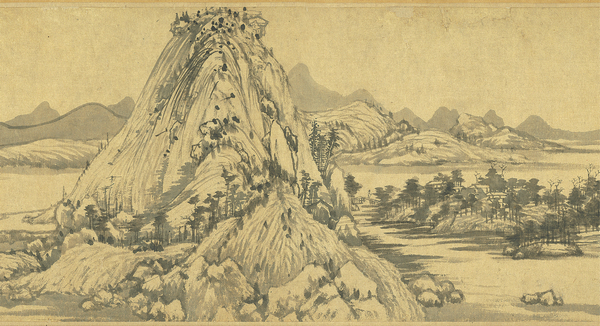Landscape of the mind

A leaf from an album of landscape paintings Wang Hui (1632-1717) did upon the request of his mentor Wang Shimin (1592-1680). Today, it is a part of an album that unites 10 surviving leaves from the original Wang Hui album with two from the original Wang Shimin album. CHINA DAILY
For Chinese literati painters, nature provides a means of self-cultivation and a way of bonding, Zhao Xu reports.
'Your disciple's embarrassing brush and ink is not worthy of entering your collections," 17th-century Chinese painter Wang Hui told his teacher Wang Shimin (1592-1680) in the inscription on a painting he did in 1674, at the latter's request.
In fact, there were 12 of them, forming an album in which the younger painter tried his hand with a variety of landscapes, each realized with the signature style of a master painter from history.
If Wang Hui, well-established by that point, had genuinely felt any inadequacy, then all the old man could do was to disagree. In fact, he was so delighted by his student's work that in the autumn of the same year, he began his own 12 renditions of old masters. This was despite "my declining energy … and weakening eyesight", to quote from Wang Shimin's inscription at the end of his own album, the completion of which took him three years.
Despite their common surname, Wang Hui was not linked to Wang Shimin, a leading figure of the Chinese art scene at the time, by blood. Yet the two shared other, more important things: a love of history and a mutual devotion inspired by genuine appreciation.

A leaf from a similar album painted by Wang Shimin after seeing what his student had done. Today, it is a part of an album that unites 10 surviving leaves from the original Wang Hui album with two from the original Wang Shimin album. CHINA DAILY
One man they both acknowledged in painting is Zhao Mengfu (1254-1322), who elucidated the idea that painting and calligraphy, by nature of their brushwork, were of the same origin.
Of the 12 leaves Wang Shimin painted, 10 are lost now. But for those who know the story — among them Joseph Scheier-Dolberg, curator of Chinese painting and calligraphy from the Metropolitan Museum of Art, great comfort could be gained from the fact that the remaining two leaves from the elder Wang were later combined with 10 surviving ones from his disciple's album to make it 12 again. And they are now on display at the US museum, in an exhibition titled Learning to Paint in Premodern China.
"Imagine that you are a talented, artistically inclined youngster from ancient China, how would you develop your skills and knowledge?" prompts the curator, whose answers come in the form of over 80 works that fill up seven galleries on the museum's second floor.
An apparent one is to learn from those who could indeed paint. Here distinction must be made between professional painters and their literati counterparts. Operating from workshops over consignments, the first group of painters typically passed their treasured means of living on to both recruited disciples and younger generations of the family. (The imperial courts were often served by generations of painting families in succession.)
To do justice to their little-acknowledged yet nonetheless indispensable role in disseminating knowledge on painting, the curator has included one piece produced by such workshops, where "groups of artists sometimes used models and templates for different element of a painting — buildings or figures for instance — that could be moved around in a modular fashion for efficient production".
The second group, whose members by definition were equally versed in painting, literature and calligraphy, tended to be more exclusive. Priding themselves on being able to create art informed by lofty texts and refined feeling, for the purpose of self-cultivation, these men — and on rare occasions women — received a holistic education that was simply beyond the reach of an average youngster.
Unless one was as talented as Wang Hui. Born into a family of professional painters, Wang Hui proved that he had more than techniques under his command. The young man caught the sharp eye of someone no less than Wang Shimin, who himself descended from a lustrous line of scholar-officials.
The result? Wang Hui was brought into the fold by the elder Wang, around whom "a critical mass of artists and collectors coalesced" to use Scheier-Dolberg's words. This enabled him among other things the viewing of hugely important works from the preceding eras, amassed by the members of this elite group who generally held the idea that history was the best teacher of all.
Words inscribed by Wang Hui on a painting of his own testified to the sense of awe he felt encountering a "small scroll" by a 10th-century painting master. "(In it) clouds and peaks race together with a luxuriant and dense air. It pierced my heart and dazzled my eyes," wrote Wang Hui, who years later commemorated that experience with his own version of billowing clouds and massive rocks "rolling toward us like a thunderstorm" to quote Maxwell Hearn, leading curator of Chinese painting in the United States and head of the museum's Asian art department. The effort was aimed at, according to the painter himself, "capturing the deep and heroic atmosphere of the north country, rather than its mere postures and prettiness".
On view at the exhibition, Wang Hui's creation may have spoken powerfully to his close friend Wang Yuanqi (1642-1715), who was also the most artistically accomplished grandson of Wang Shimin. The latter was featured in the Met show with his grandest surviving work — a 20-meterlong handscroll through which the torchbearer of his influential art family "cycled … with his interpretation of different old master styles", to use the words of Scheier-Dolberg.
"He started with Huang Gongwang (1269-1354), moved on to Huang's younger contemporary Ni Zan (1301-74) and a number of others, and then back to Huang again," the curator says. "This is effectively a visual essay on the history of Chinese painting, underlined by Wang Yuanqi's personal style. But the painter was also showing a little bit of his own training. He once wrote that 'when I was young, my grandfather (Wang Shimin) started me with Huang Gongwang'."

Dwelling in the Fuchun Mountains, painted by Huang Gongwang (1269-1354). Shown here is a section of the part of the painting kept at the Palace Museum in Taipei. CHINA DAILY
It's only natural, says Scheier-Dolberg, who considers Huang's Dwelling in the Fuchun Mountains, painted between 1348 and 1350, "the greatest surviving painting in Chinese history".
"The reason those of us who love Chinese literati painting love it is that you can enjoy it 100 percent as abstract art and you can enjoy it 100 percent as representational art," he says. "It's a landscape — it does take you somewhere. But it's also brush-strokes, so expressive of the artist himself and so exquisite that they exist at a whole other level."
"You look at that painting and you can have the entire experience you would have looking at a Jackson Pollock, plus the entire experience you would have looking at the landscape through a window," the curator adds.
The painting was at one point owned by Dong Qichang (1555-1636), a man who many today believe had dominated the Chinese art scene for 300 years until the early 20th century. "My model! My model!" Dong raved about on the 7-meter-long handscroll, which he probably had gazed upon to his heart's content, before selling it reluctantly to a private collector, who later passed it on to his own son, a man named Wu Hongyu.
In 1650, shortly after Wu's death, the painting was committed to the flames by people carrying out Wu's posthumous will to have it burned so that he could take it with him to his afterlife. A family member jumped to its rescue on the spot, but the painting was already partially destroyed and broken into two parts, which eventually found their separate ways to the Palace Museum in Taipei and the Zhejiang Provincial Museum in Hangzhou city, not far away from the Fuchun Mountains it depicts. The two parts were united briefly during an exhibition held in Taiwan in 2011.
"This kind of treasure is watched over by ghosts and spirits and jealously guarded by heaven and earth," wrote Li Moyuan, a 19th-century collector, in a colophon to his most prized item — the combined album of Wang Hui and Wang Shimin. The man would probably have similar things to say about Huang Gongwang's painting.
In that same colophon, Li, humbled by the two masters' brushwork to question himself "who am I to possess this?", recounted in detail the passing of the original two albums to Qiuya, one of Wang Shimin's grandsons, after the elder Wang's passing. That was before the works went through various travails in the ensuing century.
Back in 1714, Qiuya paid a visit to Wang Hui and showed him the album of paintings the latter created exactly four decades earlier, at the request of his grandfather Wang Shimin.
"When Master Fengchang (Wang Shimin) asked me to do this album, he was 83 … now I am of the same age," an apparently emotional Wang Hui lamented in writing attached to the existing album and now on view at the exhibition.
"The bonds of brush and ink that connect me with three generations of the Wang family cannot have been an accident."
Related articles
-
 'China Today' arts week held in South Australia
'China Today' arts week held in South AustraliaMore
-
 Collection show at National Art Museum salutes grassroots workers
Collection show at National Art Museum salutes grassroots workersMore
-
 Oil artist keeps pushing the frontier
Oil artist keeps pushing the frontierMore
-
 Brain Garden exhibition shows roots of creativity
Brain Garden exhibition shows roots of creativityMore
-
 Dong Xiyuan: Painting Tomorrow
Dong Xiyuan: Painting TomorrowMore
-
 An eruption of vitality and celebration of lives under the tones of Tibet
An eruption of vitality and celebration of lives under the tones of TibetMore
